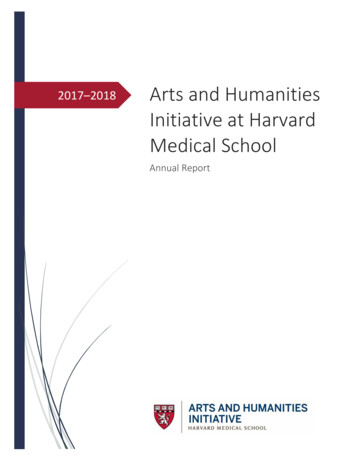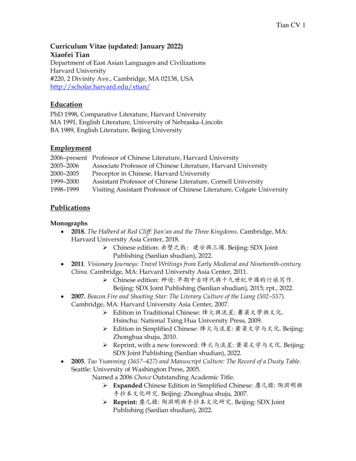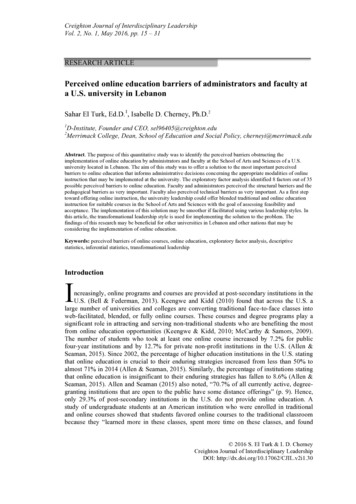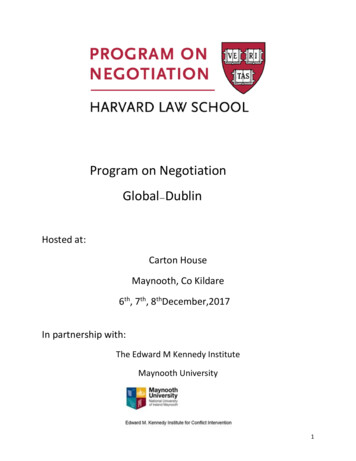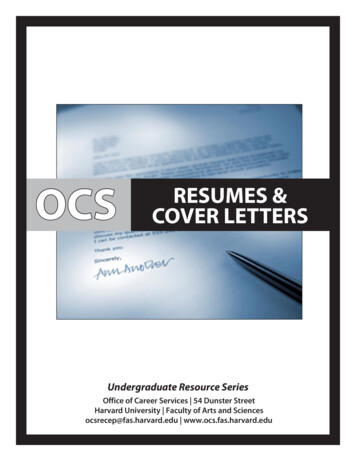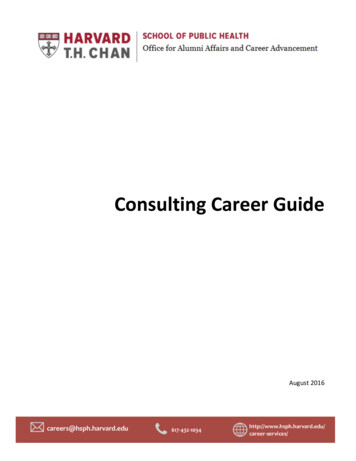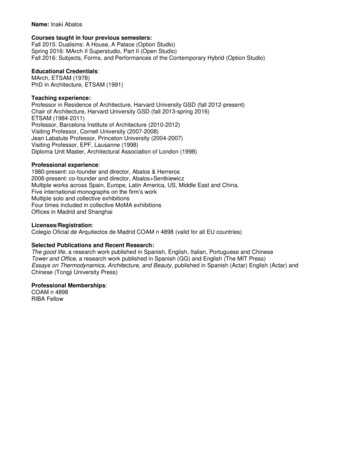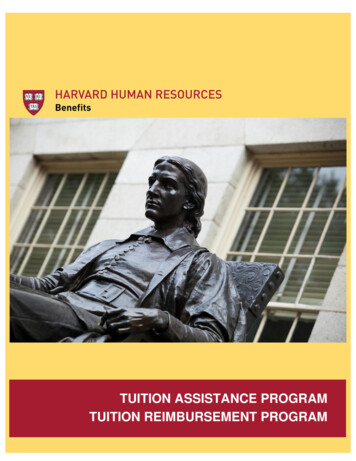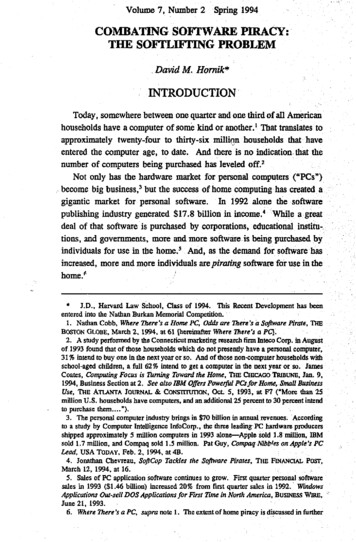
Transcription
Volume 7, Number 2Spring 1994COMBATING SOFTWARE PIRACY:THE S O F T L GPROBLEMDavid 3/1. Hornik*INTRODUCTIONToday, somewhere between one quarter and one third of all Americanhouseholds have a computer of some kind or another.t That translates toapproximately twenty-four to thirty-six million households that haveentered the computer age, to date. And there is no indication that thenumber of computers being purchased has leveled off. 2Not only has the hardware market for personal computers ("PCs )become big business, 3 but the success of home computing has created agigantic market for personal software. In 1992 alone the softwarepublishing industry generated 17.8 billion in income? While a greatdeal of that software is purchased by corporations, educational institutions, and governments, more and more software is being purchased byindividuals for use in the home. 5 And, as the demand for software hasincreased, more and more individuals are pirating software for use in thehome. * J.D., Harvard Law School, Class of 1994. This Recent Development has beenentered into the Nathan Burkan Memorial Competition.1. Nathan Cobb, Where There's a Home PC, Odds are There's a Software Pirate, THEBOSTON GLOBE, March 2, 1994, at 61 [hereinafter Where There's a PC].2. A study performed by the Connecticut marketing research finn Inteco Corp. in Augustof 1993 found that of those households which do not presently have a personal computer,31% intend to buy one in the next year or so. And of those non-computer households withschool-aged children, a full 62% intend to get a computer in the next year or so. JamesCoates, Computing Focus is Taming Toward the Home, THE CHICAGO TRIBUI , Jan. 9,1994, Business Section at 2. See also IBM Offers Powerful PCs for Home, Small BusinessUse, THE ATLANTA JOURNAL&. CONSTITUTION, Oct. 5, 1993, at F7 ("More than 25million U.S. households have computers, and an additional 25 percent to 30 percent intendto purchase them.").3. The personal computer industry brings in 70 billion in annual revenues. Accordingto a study by Computer Intelligence InfoCorp., the three leading PC hardware producersshipped approximately 5 million computers in 1993 alone---Apple sold 1.8 million, IBMsold 1.7 million, and Compaq sold 1.5 million. Pat Guy, Compaq Nibbles on Apple's PCLead, USA TODAY, Feb. 2, 1994, at 4B.4. Jonathan Chevreau, oflCop Tackles the Software Pirates, THE FINANCIAL POST,March 12, 1994, at 16.5. Sales of PC application software continues to grow. First quarter personal softwaresales in 1993 ( 1.46 billion) increased 20% from first quarter sales in 1992. grmdowsApplications Out-sell DOS Applications for First Time in North America, BUSINESSWIRE,June 21, 1993.6. Where There's a PC, supra note 1. The extent of home piracy is discussed in further
378Harvard Journal of Law & Technology[Vol. 7 oftware piracy" to a large extenthas become a generic term for theillicit duplication of copyrighted computer.software.7 This general use ofthe term "piracy, however, encompasses what can be seen as threedistinct categories of piracy: 1) commercial piracy; 2) corporate piracy;and 3) softlifting. Commercial piracy refers to the illicit duplication ofsoftware for the purpose of distribution and s a l e ) Corporate piracy, onthe other hand, rarely entails copying software for direct financial gain.Rather, corporate pirates often find that the size and scope of theircompany's software usage makes tracking and enforcement of softwarecopyrights exceedingly difficult. 9 The category of corporate piracyencompasses the activities of not only corporations and businesses, butalso educational institutions, government entities, etc. 1 detail, infra notes 92-106.7. See, e.g., Sega Enterprises Ltd. v. Accolade, Inc., No. 92-15655, 1993 U.S.App.LEXIS 78, at *7 (9th Cir. Jan 6, 1993) (using piracy" in a strictly commercial sense,refem, g to international software counterfeiting); Vault Corp. v. Quaid Software Ltd., 847F.2d 255, 261 n.13 (5th Cir. 1988) (using piracy broadly to refer to any illicit copyingthat may result in a lost sale).8. See Trade Losses Due to Piracy and Other Market Access Barriers Affecting the U.S.Copyright Industries, THE INTERNATIONALINTELLECTUALPROPERTY AI22AIqC'E, April,1989. Commercial piracy is big business. Commercial pirates save millions of dollars inresearch and development costs by simply making perfect copies of other publisher's software, repackaging it and selling it as a legitimate version of the original. It is just suchcommercial piracy at which the recent felony provisions of the copyright laws were enacted.18 U.S.C. § 2319 (1993). The felony provisions are discussed further infra at notes 86-88.See also H.R. Rep. No. 997, 102d Cong., 2rid Sess., reprinted in 1992 USCCAlq 3569,3572 (discussing scope and aim of bill felonizing commercial piracy)[hereinafter CommercialPiracy Report].The vast majority of commercial piracy takes pl' ce outside of the United States,primarily in Taiwan, Indonesia, Singapore, and Thailand. Alice Bredin, How to Spot BogusSoftware, COMPUTERWORLD,March 8, 1993, at 128. For example, after a concerted effortby the Business Software Alliance, the percentage of software in Taiwan that is counterfeitstill remains at 83%, down from 90%. Taiwan Working to Eliminate Software Piracy,CENTRAL NEWS AGENCY, April 16, 1994. Despite its prevalence abroad, commercialpiracy also takes place in the United States. In 1992, Microsoft Seized 150,000 counterfeitcopies of its program, MS DOS, version 5. The estimated street value of the piratedsoftware was over 9 million. Microsoft Raids Lead to Largest Counterfeit Software Seizurein History, BUSINESSWIRE, Oct. 7, 1992.9. The problem of corporate piracy has decreased substantially over the past few years.Corporations and other similarly situated institutions have begun taking the job ofcompliance with the copyright laws seriously, by hiring software managers to ensurecompliance, incorporating technical means by which to track software, enacting anti-piracypolicies, budgeting sufficient funds for software, etc. See Sherman and Homik, How toAvoid the Software Police and What to do When They Knock on Your Door, 15TH A LCOMPUTER LAW INSTITUTE, vol. 1,495, 528-547 (1993)[hereinafter Software Police].10. These corporate pirates have been the primary targets of recent enforcement effortsby the Software Publishers Association, the industry trade organization charged with the taskof copyright enforcement. See, e.g., SPA Made 1993 a Bad Year for Software Pirates,BUSINESSWIRE, Jan. 25, 1994 [hereinafter Bad Yearfor Pirates]. Typical corporate piracy
No. 2]Combating Software Piracy379The final category of software piracy is that upon which this paperfocuses: softlifting. Softlifting is the software equivalent of shoplifting, ttWhen one copies a friends software package, or brings a backup copyhome from work for personal use, or borrows a program from the libraryand makes a copy of it, each of these acts amounts to softlifting. In thewords of John Robards, a staff member of the Boston Computer Society,softlifting is one of life's quiet little cheats. "n Softlifting is that piracywhich goes on in our homes, behind closed doors, where no one can seeit happening; it is not intended for direct financial gain, and is believedby many to be perfectly legal.13Software publishers have expended significant resources over the pastdozen or so years in an effort to combat all forms of piracy. They havebanded together in such trade organizations as the Software PublishersAssociation ("SPA"), the Association of Data Processing ServiceOrganizations ("ADAPSO"), 4 and the Business Software Alliance("BSA") to fight piracy not only in the courts, but also in Congress, andin the press.t5 Those efforts have been relatively successful with regardto commercial 6 and corporate piracy, 7 but have been unable to attacktakes the form of a piece of software being passed around the office and placed on multiplehard drives or copied onto a fde server which is accessed by many more people than asingle user. The result is that a corporation will have purchased only a handful of copiesof a particular program, yet have dozens of employees utilizing copies of that software. SeeThou Shalt Not Dupe; So Says a Vendor of Software--is Anyone Listening?, COMPUrERWORLD, Jan. 28, 1985.1I. See Ayen, Why You Shouldn't Pirate Software, THE AMERICANLAWYER, Dec. 1993,at 102 (U[B]ecause of the ease of duplication, many individuals who would never think ofshoplifting a candy bar think nothing of offering up any number of excuses for piratingsoftware . . . . ").12. Where There's a PC, supra note 1, at 61. See also Software Police, supra note 9,at 501, n.1.13. See Pamela Samuelson, Computer Programs and Copyright's Fair Use Doctrine,COMMUNICATIONSOFTHE ACM, Sept. 1993, at 19 (U[There exists] a widespread perceptionof the general public that making copies of copyrighted works is OK as long as it's done forprivate, non-commercial purposes.").14. ADAPSO was the predecessor of tbe InformationTechnulogy Association of America("ITAA") and received somewhat greater visibility than has the ITAA.15. For a discussion of the litigation efforts of the software community, see/nfra notes48-84 and accompanying text. The primary legislative victories of the software publishershave been the enactment of the Computer Software Rental Amendments Act of 1990,codified under 17 U.S.C. § 109(b) (1993), and the Commercial Piracy FelonizationProvisions, codified under 18 U.S.C. § 2319 (1993). See/nfra notes 86-88 and accompanying text. For a discussion of recent efforts at educating the public, see/nfra notes 109q 17.16. Under the new felony provisions of the copyright act, the first domestic commercialpirate was indicted on July 7, 1993. With a potential sentence of 250,000 ( I,000,000 forcorporate defendants) and five years in prison ( en years for repeat offenders), theseheightened penalties send a strong message to potential commercial pirates. FirstIndictments Come Down Under Stronger Software Piracy Laws, THE ASSOCIATEDPRESS,
380Harvard Journal of Law & Technology[Vol. 7softlifting in any serious way.::This paper attempts ,o address the growing problem of softlifting. Itfirst considers the present efforts at copyright enforcement beingundertaken by organizations like the SPA. This section focuses on thoseorganizations fighting software piracy, as well as on the legal toolsavailable to effectuate such enforcement strategies under the copyrightlaws. Second, this paper explores the possibility of a legislative solutionto the softlifting problem. The legislative model explored is that whichwas recently enacted to protect intellectual property in the audio realm.Specifically, the solution considered is modeled after the Audio HomeRecording Act, Is which combines a royalty scheme with a proposedtechnical anti-copying solution.I. T H E S O F T W A R EP O L I C E 19Despite the heated debate in recent years over the copyrightability ofcomputer programs, it is now firmly established that software is protectedby the copyright laws .20Armed with the copyright act and its enforcementprovisions, the software industry has begun vigilantly protecting itsintellectual property rights. 2 These enforcement efforts have beenJuly 7, 1993. The SPA has also begun fighting commercial piracy abroad, initiating threeraids in Singapore in 1993. Bad Year for Pirates, supra note 10.17. Since the inception of the SPA's anti-piracy campaign (a combination of litigation andeducation), some estimate that corporate piracy has been cotby almost 50%. Retail ChainSettles Software Suit; Pays 161,000 to Software Publishers Association, BUSINESSWIRE,Nov. 12, 1993. Piracy decreased siga;/icanfly between 1991 and 1992 alone, from 2billion in industry lesses down to 1.2 billion. Laura DiDio, Crackdown on So .,areBootleggers Hits Home, LAN TIMES, Nov. 1, 1993, at 67 (quoting Ken Wasch, SPAexecutive director). See also Bad Yearfor Pirates, supra note 10. But See Mark Trombull.Software Piracy Grows, As Do Efforts to Stop It, THE CmUS'HANSCn NCEMONITOR, Dec;7, 1993, at 9 ('Unlike the larger Software Publishers Association, the [Business SoftwareAlliance] sees the problem holding steady in the U.S.; rather than declining.P).18. Audio Home Recording Act of 1992, 17 U.S.C. §§ 1001, et seq. (1993).19. Section I of this paper builds upon a previously published work. Software Police,supra note 9. Many thanks to Cary Sherman of Arnold & Porter, Washington, D.C., forhis assistance and support.20. See generally FINAL P.,EI RT OF THE NATIONAL COMMISSION ON NEW TECHNOLOGICALUSES OF CO . 'Gln'ED WORKS, 1978 [hereinafter CONTU Report]; 17 U.S.C.§ 117 (1993) (backup copies of software are non-infringing).21. While software publishers have alsu sought to protect their intellectual proporty rightsvia licensing agreements, these agreements have proved less effective titan the copyrightlaws when it comes to enforcement strategies. This is due in large part to the questionablestatus of shrink wrap licenses. Such licenses emblazen the software packaging with theterms of the license agreement and assert enforcability upon the openning of the shrinkwrapped package. However, such contracts of adhesion are arguably unenforcable. See
No. 2]Combating Software Piracy381undertaken by software publishers both individually and in tandem, viasuch trade organizations as the SPA and the BSA. Drawing upon theentire copyright enforcement arsenal, 22 software publishers have madegreat gains in fighting corporate and commercial and corporate piracy23and in these efforts have been collectively dubbed the "software police. "uWhile the Software Police, to date, have only sought to enforce thecopyright laws against commercial and corporate pirates, the makeup ofthe police force and the nature of their enforcement arsenal are instructivewhen considering the softlifting problem. The software police
Software publishers have expended significant resources over the past dozen or so years in an effort to combat all forms of piracy. They have banded together in such


